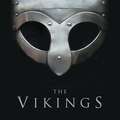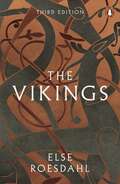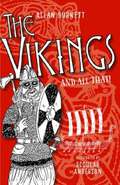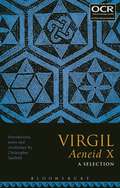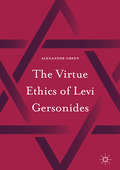- Table View
- List View
The Victory with No Name: The Native American Defeat of the First American Army
by Colin G. CallowayIn 1791, General Arthur St. Clair led the United States army in a campaign to destroy a complex of Indian villages at the Maumee River in northwestern Ohio. Almost within reach of their objective, St. Clair's 1,400 men were attacked by about one thousand Indians. The U.S. force was decimated, suffering nearly one thousand casualties in killed and wounded, while Indian casualties numbered only a few dozen. But despite the lopsided result, it wouldn't appear to carry much significance; it involved only a few thousand people, lasted less than three hours, and the outcome, which was never in doubt, was permanently reversed a mere three years later. Neither an epic struggle nor a clash that changed the course of history, the battle doesn't even have a name. Yet, as renowned Native American historian Colin Calloway demonstrates here, St. Clair's Defeat--as it came to be known-- was hugely important for its time. It was both the biggest victory the Native Americans ever won, and, proportionately, the biggest military disaster the United States had suffered. With the British in Canada waiting in the wings for the American experiment in republicanism to fail, and some regions of the West gravitating toward alliance with Spain, the defeat threatened the very existence of the infant United States. Generating a deluge of reports, correspondence, opinions, and debates in the press, it produced the first congressional investigation in American history, while ultimately changing not only the manner in which Americans viewed, raised, organized, and paid for their armies, but the very ways in which they fought their wars. Emphasizing the extent to which the battle has been overlooked in history, Calloway illustrates how this moment of great victory by American Indians became an aberration in the national story and a blank spot in the national memory. Calloway shows that St. Clair's army proved no match for the highly motivated and well-led Native American force that shattered not only the American army but the ill-founded assumption that Indians stood no chance against European methods and models of warfare. An engaging and enlightening read for American history enthusiasts and scholars alike, The Victory with No Name brings this significant moment in American history back to light.
The Vietnam Nationalist Party (1927-1954)
by Van Khanh NguyenThis book presents research focusing on the Vietnam Nationalist Party (Việt Nam Quốc dân đảng) from 1927 to 1954. It elaborates on the party’s establishment, political ideology and organizational structure, the Yen Bai Uprising, the party’s downfall, and its role in the Vietnamese Revolution. Findings are presented systematically and comprehensively, relying on official and unofficial, as well as domestic and foreign sources, including texts from localities and hometowns of vital figures in the organization. The author compares, contrasts and evaluates this complex collection of documents based on the theoretical perspectives of conflict theory, social system theory, social structuralism and functionism, dialectic materialism and Marxist theory. It is essential reading for Vietnamese and international researchers interested in Vietnam’s political context in the early twentieth century and for undergraduate and postgraduate programs in Vietnam’s history and politics.
The Vietnam War: A Documentary Reader (Uncovering the Past: Documentary Readers in American History)
by Edward MillerThe Vietnam War is an outstanding collection of primary documents related to America’s conflict in Vietnam which includes a balance of original American and Vietnamese perspectives, providing a uniquely varied range of insights into both American and Vietnamese experiences. Includes substantial non-American content, including many original English translations of Vietnamese-authored texts which showcase the diversity and complexity of Vietnamese experiences during the war Contains original American documents germane to the continuing debates about the causes, consequences and morality of the US intervention Incorporates personal histories of individual Americans and Vietnamese Introductory headnotes place each document in context Features a range of non-textual documents, including iconic photographs and political cartoons
The Vietnam War: A Documentary Reader (Uncovering the Past: Documentary Readers in American History)
by Edward MillerThe Vietnam War is an outstanding collection of primary documents related to America’s conflict in Vietnam which includes a balance of original American and Vietnamese perspectives, providing a uniquely varied range of insights into both American and Vietnamese experiences. Includes substantial non-American content, including many original English translations of Vietnamese-authored texts which showcase the diversity and complexity of Vietnamese experiences during the war Contains original American documents germane to the continuing debates about the causes, consequences and morality of the US intervention Incorporates personal histories of individual Americans and Vietnamese Introductory headnotes place each document in context Features a range of non-textual documents, including iconic photographs and political cartoons
The Viking Saga (A Puffin Book)
by Henry TreeceInto this breathtaking trilogy is woven the true spirit of the Vikings, who great thirst for travelling the seas took them on incredible voyages in defiance of icy waters, terrible hardships and bloodthirsty resistance.It is AD 780. Viking's Dawn sees a young Norse boy, Harald Sigurdson, set sail for the Hebrides in the longship 'Nameless'. The goal: to plunder the helpless coastal villages of Britain.Just five years later, undeterred by his first desperate journey, the dauntless warrior puts to sea once again, in The Road to Miklagard - this time lured by the news of a fabulous hoard of treasure. After a lifetime struggling with the bitter waves, Harald embarks on his last voyage in Viking's Sunset, this time not for gain but to seek vengeance on a blood enemy.
The Vikings: Voyagers Of Discovery And Plunder (General Military Ser.)
by René Chartrand Keith Durham Mark Harrison Ian HeathThe history of the Vikings is bloody and eventful, and Viking warriors capture the popular imagination to this day. They made history, establishing the dukedom of Normandy, providing the Byzantine Emperors' bodyguard and landing on the shores of America 500 years before Columbus. Beautifully illustrated with colour photographs and original Osprey artwork, this book presents a new window into their way of life including detailed studies of the Hersir, the raiding warrior of the Viking world, and the legendary Viking longship.
The Vikings: The Viking-age Settlement And Fortress (Jutland Archaeological Society Publications #82)
by Else RoesdahlFar from being just 'wild, barbaric, axe-wielding pirates', the Vikings created complex social institutions, oversaw the coming of Christianity to Scandinavia and made a major impact on European history through trade, travel and far-flung consolidation. This encyclopedic study brings together the latest research on Viking art, burial customs, class divisions, jewellery, kingship, poetry and family life. The result is a rich and compelling picture of an extraordinary civilisation.
The Vikings and All That (The\and All That Ser.)
by Allan BurnettVikings and All That is a skull-splitting saga about the wild, seafaring warriors who burst into history in the 8th century and looted, plundered, pillaged and burned their way from their native Scandinavia to the British Isles and much of Europe. Packed with fantastic, fun illustrations of everything from the Vikings' warships to their favourite board games, this is the book that answers all the key questions you might have. If you want sensible answers, packed with historical facts and thoughtful revelations about the Vikings' civilised side then this is the book for you. But if you want boatloads of bearded, shield-biting maniacs bearing down on defenceless, sandal-wearing villagers, then this is DEFINITELY the book for you!
Violence and the City in the Modern Middle East
by Nelida FuccaroThis book explores violence in the public lives of modern Middle Eastern cities, approaching violence as an individual and collective experience, a historical event, and an urban process. Violence and the city coexist in a complicated dialogue, and critical consideration of the city offers an important way to understand the transformative powers of violence—its ability to redraw the boundaries of urban life, to create and divide communities, and to affect the ruling strategies of local elites, governments, and transnational political players. The essays included in this volume reflect the diversity of Middle Eastern urbanism from the eighteenth to the late twentieth centuries, from the capitals of Cairo, Tunis, and Baghdad to the provincial towns of Jeddah, Nablus, and Basra and the oil settlements of Dhahran and Abadan. In reconstructing the violent pasts of cities, new vistas on modern Middle Eastern history are opened, offering alternative and complementary perspectives to the making and unmaking of empires, nations, and states. Given the crucial importance of urban centers in shaping the Middle East in the modern era, and the ongoing potential of public histories to foster dialogue and reconciliation, this volume is both critical and timely.
Violence as a Generative Force: Identity, Nationalism, and Memory in a Balkan Community
by Max BergholzDuring two terrifying days and nights in early September 1941, the lives of nearly two thousand men, women, and children were taken savagely by their neighbors in Kulen Vakuf, a small rural community straddling today’s border between northwest Bosnia and Croatia. This frenzy—in which victims were butchered with farm tools, drowned in rivers, and thrown into deep vertical caves—was the culmination of a chain of local massacres that began earlier in the summer. In Violence as a Generative Force, Max Bergholz tells the story of the sudden and perplexing descent of this once peaceful multiethnic community into extreme violence. This deeply researched microhistory provides provocative insights to questions of global significance: What causes intercommunal violence? How does such violence between neighbors affect their identities and relations? Contrary to a widely held view that sees nationalism leading to violence, Bergholz reveals how the upheavals wrought by local killing actually created dramatically new perceptions of ethnicity—of oneself, supposed "brothers," and those perceived as "others." As a consequence, the violence forged new communities, new forms and configurations of power, and new practices of nationalism. The history of this community was marked by an unexpected explosion of locally executed violence by the few, which functioned as a generative force in transforming the identities, relations, and lives of the many. The story of this largely unknown Balkan community in 1941 provides a powerful means through which to rethink fundamental assumptions about the interrelationships among ethnicity, nationalism, and violence, both during World War II and more broadly throughout the world.
Violent Entrepreneurs: The Use of Force in the Making of Russian Capitalism
by Vadim VolkovEntering the shady world of what he calls "violent entrepreneurship," Vadim Volkov explores the economic uses of violence and coercion in Russia in the 1990s. Violence has played, he shows, a crucial role in creating the institutions of a new market economy. The core of his work is competition among so-called violence-managing agencies—criminal groups, private security services, private protection companies, and informal protective agencies associated with the state—which multiplied with the liberal reforms of the early 1990s. This competition provides an unusual window on the dynamics of state formation.Violent Entrepreneurs is remarkable for its research. Volkov conducted numerous interviews with members of criminal groups, heads of protection companies, law enforcement employees, and businesspeople. He bases his findings on journalistic and anecdotal evidence as well as on his own personal observation.Volkov investigates the making of violence-prone groups in sports clubs (particularly martial arts clubs), associations for veterans of the Soviet—Afghan war, ethnic gangs, and regionally based social groups, and he traces the changes in their activities across the decade. Some groups wore state uniforms and others did not, but all of their members spoke and acted essentially the same and were engaged in the same activities: intimidation, protection, information gathering, dispute management, contract enforcement, and taxation. Each group controlled the same resource—organized violence.
Violent Reverberations: Global Modalities of Trauma (Culture, Mind, and Society)
by Vigdis Broch-Due Bjørn Enge BertelsenThe contributions to this volume map the surprisingly multifarious circumstances in which trauma is invoked – as an analytical tool, a therapeutic term or as a discursive trope. By doing so, we critically engage the far too often individuating aspects of trauma, as well as the assumption of a universal somatic that is globally applicable to contexts of human suffering. The volume takes the reader on a journey across widely differing terrains: from Norwegian institutions for psychiatric patients to the post-war emergence of speech genres on violence in Mozambique, from Greek and Cameroonian ritual and carnivalesque treatments of historical trauma to national discourses of political assassinations in Argentina, the volume provides an empirically founded anti-dote against claiming a universal ‘empire of trauma’ (Didier Fassin) or seeing the trauma as successfully defined by the Diagnostic and Statistical Manual of Mental Disorders (DSM). Instead, the work critically evaluates and engages whether the term’s dual plasticity and endurance captures, encompasses or challenges legacies and imprints of multiple forms of violence.
Violent Sensations: Sex, Crime, and Utopia in Vienna and Berlin, 1860-1914
by Scott SpectorAround the turn of the twentieth century, Vienna and Berlin were centers of scientific knowledge, accompanied by a sense of triumphalism and confidence in progress. Yet they were also sites of fascination with urban decay, often focused on sexual and criminal deviants and the tales of violence surrounding them. Sensational media reports fed the prurient public’s hunger for stories from the criminal underworld: sadism, sexual murder, serial killings, accusations of Jewish ritual child murder—as well as male and female homosexuality. In Violent Sensations, Scott Spector explores how the protagonists of these stories—people at society’s margins—were given new identities defined by the groundbreaking sciences of psychiatry, sexology, and criminology, and how this expert knowledge was then transmitted to an eager public by journalists covering court cases and police investigations. The book analyzes these sexual and criminal subjects on three levels: first, the expertise of scientists, doctors, lawyers, and scholars; second, the sensationalism of newspaper scandal and pulp fiction; and, third, the subjective ways that the figures themselves came to understand who they were. Throughout, Spector answers important questions about how fantasies of extreme depravity and bestiality figure into the central European self-image of cities as centers of progressive civilization, as well as the ways in which the sciences of social control emerged alongside the burgeoning emancipation of women and homosexuals.
Violent Sensations: Sex, Crime, and Utopia in Vienna and Berlin, 1860-1914
by Scott SpectorAround the turn of the twentieth century, Vienna and Berlin were centers of scientific knowledge, accompanied by a sense of triumphalism and confidence in progress. Yet they were also sites of fascination with urban decay, often focused on sexual and criminal deviants and the tales of violence surrounding them. Sensational media reports fed the prurient public’s hunger for stories from the criminal underworld: sadism, sexual murder, serial killings, accusations of Jewish ritual child murder—as well as male and female homosexuality. In Violent Sensations, Scott Spector explores how the protagonists of these stories—people at society’s margins—were given new identities defined by the groundbreaking sciences of psychiatry, sexology, and criminology, and how this expert knowledge was then transmitted to an eager public by journalists covering court cases and police investigations. The book analyzes these sexual and criminal subjects on three levels: first, the expertise of scientists, doctors, lawyers, and scholars; second, the sensationalism of newspaper scandal and pulp fiction; and, third, the subjective ways that the figures themselves came to understand who they were. Throughout, Spector answers important questions about how fantasies of extreme depravity and bestiality figure into the central European self-image of cities as centers of progressive civilization, as well as the ways in which the sciences of social control emerged alongside the burgeoning emancipation of women and homosexuals.
Violent Sensations: Sex, Crime, and Utopia in Vienna and Berlin, 1860-1914
by Scott SpectorAround the turn of the twentieth century, Vienna and Berlin were centers of scientific knowledge, accompanied by a sense of triumphalism and confidence in progress. Yet they were also sites of fascination with urban decay, often focused on sexual and criminal deviants and the tales of violence surrounding them. Sensational media reports fed the prurient public’s hunger for stories from the criminal underworld: sadism, sexual murder, serial killings, accusations of Jewish ritual child murder—as well as male and female homosexuality. In Violent Sensations, Scott Spector explores how the protagonists of these stories—people at society’s margins—were given new identities defined by the groundbreaking sciences of psychiatry, sexology, and criminology, and how this expert knowledge was then transmitted to an eager public by journalists covering court cases and police investigations. The book analyzes these sexual and criminal subjects on three levels: first, the expertise of scientists, doctors, lawyers, and scholars; second, the sensationalism of newspaper scandal and pulp fiction; and, third, the subjective ways that the figures themselves came to understand who they were. Throughout, Spector answers important questions about how fantasies of extreme depravity and bestiality figure into the central European self-image of cities as centers of progressive civilization, as well as the ways in which the sciences of social control emerged alongside the burgeoning emancipation of women and homosexuals.
Violent Sensations: Sex, Crime, and Utopia in Vienna and Berlin, 1860-1914
by Scott SpectorAround the turn of the twentieth century, Vienna and Berlin were centers of scientific knowledge, accompanied by a sense of triumphalism and confidence in progress. Yet they were also sites of fascination with urban decay, often focused on sexual and criminal deviants and the tales of violence surrounding them. Sensational media reports fed the prurient public’s hunger for stories from the criminal underworld: sadism, sexual murder, serial killings, accusations of Jewish ritual child murder—as well as male and female homosexuality. In Violent Sensations, Scott Spector explores how the protagonists of these stories—people at society’s margins—were given new identities defined by the groundbreaking sciences of psychiatry, sexology, and criminology, and how this expert knowledge was then transmitted to an eager public by journalists covering court cases and police investigations. The book analyzes these sexual and criminal subjects on three levels: first, the expertise of scientists, doctors, lawyers, and scholars; second, the sensationalism of newspaper scandal and pulp fiction; and, third, the subjective ways that the figures themselves came to understand who they were. Throughout, Spector answers important questions about how fantasies of extreme depravity and bestiality figure into the central European self-image of cities as centers of progressive civilization, as well as the ways in which the sciences of social control emerged alongside the burgeoning emancipation of women and homosexuals.
Violent Sensations: Sex, Crime, and Utopia in Vienna and Berlin, 1860-1914
by Scott SpectorAround the turn of the twentieth century, Vienna and Berlin were centers of scientific knowledge, accompanied by a sense of triumphalism and confidence in progress. Yet they were also sites of fascination with urban decay, often focused on sexual and criminal deviants and the tales of violence surrounding them. Sensational media reports fed the prurient public’s hunger for stories from the criminal underworld: sadism, sexual murder, serial killings, accusations of Jewish ritual child murder—as well as male and female homosexuality. In Violent Sensations, Scott Spector explores how the protagonists of these stories—people at society’s margins—were given new identities defined by the groundbreaking sciences of psychiatry, sexology, and criminology, and how this expert knowledge was then transmitted to an eager public by journalists covering court cases and police investigations. The book analyzes these sexual and criminal subjects on three levels: first, the expertise of scientists, doctors, lawyers, and scholars; second, the sensationalism of newspaper scandal and pulp fiction; and, third, the subjective ways that the figures themselves came to understand who they were. Throughout, Spector answers important questions about how fantasies of extreme depravity and bestiality figure into the central European self-image of cities as centers of progressive civilization, as well as the ways in which the sciences of social control emerged alongside the burgeoning emancipation of women and homosexuals.
Violent Sensations: Sex, Crime, and Utopia in Vienna and Berlin, 1860-1914
by Scott SpectorAround the turn of the twentieth century, Vienna and Berlin were centers of scientific knowledge, accompanied by a sense of triumphalism and confidence in progress. Yet they were also sites of fascination with urban decay, often focused on sexual and criminal deviants and the tales of violence surrounding them. Sensational media reports fed the prurient public’s hunger for stories from the criminal underworld: sadism, sexual murder, serial killings, accusations of Jewish ritual child murder—as well as male and female homosexuality. In Violent Sensations, Scott Spector explores how the protagonists of these stories—people at society’s margins—were given new identities defined by the groundbreaking sciences of psychiatry, sexology, and criminology, and how this expert knowledge was then transmitted to an eager public by journalists covering court cases and police investigations. The book analyzes these sexual and criminal subjects on three levels: first, the expertise of scientists, doctors, lawyers, and scholars; second, the sensationalism of newspaper scandal and pulp fiction; and, third, the subjective ways that the figures themselves came to understand who they were. Throughout, Spector answers important questions about how fantasies of extreme depravity and bestiality figure into the central European self-image of cities as centers of progressive civilization, as well as the ways in which the sciences of social control emerged alongside the burgeoning emancipation of women and homosexuals.
A Violent World: Modern Threats to Economic Stability
by Jean-Hervé Lorenzi Mickaël BerrebiDuring the 1990s Francis Fukuyama announced the end of history. The 2000s showed how it is an illusion to imagine a peaceful world without conflict.In this book the authors explore how six major constraints are set to fix the trajectory of the global economy. Three of them are new: the aging population, the failure of technical progress, and the scarcity of savings. The other three have been at work for some time: the explosion of inequality, the mass transfer of activities from one end of the world to the other, and the limitless financialization of economy. They suggest that like seismic activity which depends on pressure between tectonic plates, the political and social tensions will be exacerbated in the coming years by these major forces. They propose that authorities will be incapable of preventing neither the date nor the intensity of the coming earthquakes, and ask the question: Are we able to cope with these future shocks and the violence they are sure to cause?
Virgil Aeneid X: A Selection
by Christopher TanfieldThis is the OCR-endorsed publication from Bloomsbury for the Latin A-Level (Group 4) prescription of Virgil's Aeneid X, giving full Latin text, commentary and vocabulary for lines 215–250, 260–307, 362–398 and 426–542. A detailed introduction covers the prescribed text to be read in English for A Level.In Book X, the story moves from a council of the gods, via a depiction of Aeneas's return by sea to his beleaguered Trojan camp, to a bloody field of battle. We see Aeneas for the first time as a heroic warrior, but also afflicted by the searing pain of loss as the young son of his new ally, entrusted to him by his father, is killed. Aeneas is for now cheated of his revenge, a revenge which is the preoccupation of the rest of the poem. He does, however, slay the son of a champion of the opposition and then the champion himself, in scenes which re-emphasise that pain.The heart of the book, where Aeneas and his allies join the fray, constitutes the OCR selection. It is an immensely powerful confrontation between violence and compassion, cruelty and nobility.
The Virtue Ethics of Levi Gersonides
by Alexander GreenThis book argues that Levi Gersonides articulates a unique model of virtue ethics among medieval Jewish thinkers. Gersonides is recognized by scholars as one of the most innovative Jewish philosophers of the medieval period. His first model of virtue is a response to the seemingly capricious forces of luck through training in endeavor, diligence, and cunning aimed at physical self-preservation. His second model of virtue is altruistic in nature. It is based on the human imitation of God as creator of the laws of the universe for no self-interested benefit, leading humans to imitate God through the virtues of loving-kindness, grace, and beneficence. Both these models are amplified through the institutions of the kingship and the priesthood, which serve to actualize physical preservation and beneficence on a larger scale, amounting to recognition of the political necessity for a division of powers.
A Virtue for Courageous Minds: Moderation in French Political Thought, 1748-1830
by Aurelian CraiutuPolitical moderation is the touchstone of democracy, which could not function without compromise and bargaining, yet it is one of the most understudied concepts in political theory. How can we explain this striking paradox? Why do we often underestimate the virtue of moderation? Seeking to answer these questions, A Virtue for Courageous Minds examines moderation in modern French political thought and sheds light on the French Revolution and its legacy. Aurelian Craiutu begins with classical thinkers who extolled the virtues of a moderate approach to politics, such as Aristotle and Cicero. He then shows how Montesquieu inaugurated the modern rebirth of this tradition by laying the intellectual foundations for moderate government. Craiutu looks at important figures such as Jacques Necker, Madame de Staël, and Benjamin Constant, not only in the context of revolutionary France but throughout Europe. He traces how moderation evolves from an individual moral virtue into a set of institutional arrangements calculated to protect individual liberty, and he explores the deep affinity between political moderation and constitutional complexity. Craiutu demonstrates how moderation navigates between political extremes, and he challenges the common notion that moderation is an essentially conservative virtue, stressing instead its eclectic nature. Drawing on a broad range of writings in political theory, the history of political thought, philosophy, and law, A Virtue for Courageous Minds reveals how the virtue of political moderation can address the profound complexities of the world today.
A Virtue for Courageous Minds: Moderation in French Political Thought, 1748-1830 (PDF)
by Aurelian CraiutuPolitical moderation is the touchstone of democracy, which could not function without compromise and bargaining, yet it is one of the most understudied concepts in political theory. How can we explain this striking paradox? Why do we often underestimate the virtue of moderation? Seeking to answer these questions, A Virtue for Courageous Minds examines moderation in modern French political thought and sheds light on the French Revolution and its legacy. Aurelian Craiutu begins with classical thinkers who extolled the virtues of a moderate approach to politics, such as Aristotle and Cicero. He then shows how Montesquieu inaugurated the modern rebirth of this tradition by laying the intellectual foundations for moderate government. Craiutu looks at important figures such as Jacques Necker, Madame de Staël, and Benjamin Constant, not only in the context of revolutionary France but throughout Europe. He traces how moderation evolves from an individual moral virtue into a set of institutional arrangements calculated to protect individual liberty, and he explores the deep affinity between political moderation and constitutional complexity. Craiutu demonstrates how moderation navigates between political extremes, and he challenges the common notion that moderation is an essentially conservative virtue, stressing instead its eclectic nature. Drawing on a broad range of writings in political theory, the history of political thought, philosophy, and law, A Virtue for Courageous Minds reveals how the virtue of political moderation can address the profound complexities of the world today.
The Virtues of Freedom: Selected Essays on Kant
by Paul GuyerThe essays collected in this volume by Paul Guyer, one of the world's foremost Kant scholars, explore Kant's attempt to develop a morality grounded on the intrinsic and unconditional value of the human freedom to set our own ends. When regulated by the principle that the freedom of all is equally valuable, the freedom to set our own ends — what Kant calls "humanity" - becomes what he calls autonomy. These essays explore Kant's strategies for establishing the premise that freedom is the inner worth of the world or the essential end of humankind, as he says, and for deriving the specific duties that fundamental principle of morality generates in the empirical circumstances of human existence. The Virtues of Freedom further investigates Kant's attempts to prove that we are always free to live up to this moral ideal, that is, that we have free will no matter what, as well as his more successful explorations of the ways in which our natural tendencies to be moral — dispositions to the feeling of respect and more specific feelings such as love and self-esteem — can and must be cultivated and educated. Guyer finally examines the various models of human community that Kant develops from his premise that our associations must be based on the value of freedom for all. The contrasts but also similarities of Kant's moral philosophy to that of David Hume but many of his other predecessors and contemporaries, such as Stoics and Epicureans, Pufendorf and Wolff, Hutcheson, Kames, and Smith, are also explored.
Virtuous or Villainess? The Image of the Royal Mother from the Early Medieval to the Early Modern Era (Queenship and Power)
by Carey Fleiner Elena WoodacreThis collection addresses royal motherhood across Europe, from both the medieval and Early Modern periods, including (in)famous and not-so-famous royal mothers. The essays in this collection reveal the complexities and the subtleties inherent in the role of royal mothers and challenges these traditional stereotypes. The volume provides a fresh re-evaluation of these women, from those who have been given an almost saintly status to those who struggled against contemporary chronicles and propaganda that perpetuated the stereotypes associated with ‘bad mothers’– these particular images of saintliness and wickedness have persisted right into the modern era. This series of intriguing case studies reveals how royal mothers were perceived by their contemporaries and explores the motivation for the ways in which they are depicted in modern popular culture. Taken together with the companion volume, Royal Mothers and their Ruling Children, this collection sheds new light on the important and challenging role of mothers within the framework of monarchy and at the epicenter of power.




